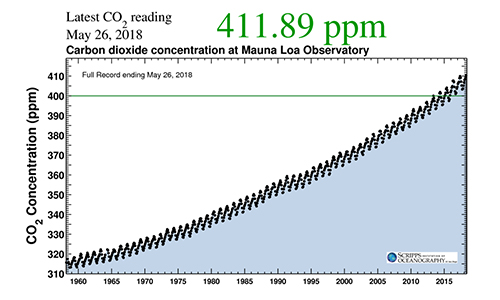Source: Drake, H. F., A. K. Morrison, S. M. Griffies, J. L. Sarmiento, W. Weijer, and A. R. Gray (2018), Lagrangian Timescales of Southern Ocean Upwelling in a Hierarchy of Model Resolutions. Geophysical Research Letters, doi: 10.1002/2017GL076045
Southern Ocean Sink
By taking up excess carbon dioxide and heat from the atmosphere, the ocean plays a crucial role in regulating the earth’s climate and damping the effects of global warming. The ocean surrounding Antarctica, called the Southern Ocean, absorbs a particularly large amount of CO2 and heat. In fact, the Southern Ocean has absorbed nearly 30% of the carbon and 90% of the heat associated with anthropogenic climate change.
The Southern Ocean is so good at trapping carbon dioxide because it is one of the only places on earth where the atmosphere can communicate directly with the deep ocean. This is due to a unique current system called the overturning circulation that moves water between the surface and the ocean abyss.
Taking measurements in the Southern Ocean is difficult due to its remote location and harsh weather. Because there is so little available data, studying Southern Ocean upwelling, the process that brings water from the deep ocean to the surface, is impossible using observations alone. Therefore, a new study by Drake et al. uses several different climate models to examine upwelling pathways. Studying the timing and distribution of these pathways is important because it will help us better understand the ocean’s ability to absorb heat and carbon dioxide from the atmosphere.

Model Behavior
In their study, the researchers released virtual particles into the simulated currents from several different climate models. Then they tracked the position of the particles as they spiraled upwards to the surface. By using several different models, they were able to compare pathways and thus test how sensitive the transports were to the specific model that was used. In particular, the main question the researchers were trying to investigate was how model resolution affects the amount of time it takes for particles to upwell.
Model resolution can be thought of like the image quality of a picture. Climate models divide the world into a three-dimensional grid. The resolution of a model describes the size of these grid boxes. Just as a high-resolution photograph has many pixels, a high-resolution climate model similarly has many grid boxes. And just as a high-resolution photograph allows you to see small details more easily, a high-resolution climate model is able to capture smaller scale processes and features.

Resolution Matters
Drake et al. tracks upwelling trajectories in 3 different model resolutions. They found that particles take 87 years to upwell in the coarsest climate model, but only 17 years in the highest resolution model. The reason for this discrepancy is likely related to the vortices and eddies (circular currents) which are too small to be captured in the coarse resolution model. These smaller-scale processes cause mixing that makes particles upwell more quickly.

The disagreement in upwelling timescale between model resolutions has some important ramifications. For example, in the coarse model, particles circle around Antarctica 3.2 times before reaching the surface. In the higher resolution model however, since the time it takes to upwell is shorter, the particles only circle around Antarctica 0.9 times. This means that the different kinds of upwelling waters have more time to mix with each other in coarse resolution models, which could impact the ocean’s ability to absorb heat.
The transport of water from the deep ocean to the surface affects everything from circulation patterns to uptake of heat and carbon dioxide. Therefore, accurately predicting upwelling location and timing is crucial to understanding and modeling global climate. In order to do this, it is necessary to assess the ability of models to capture upwelling as Drake et al. did in this study. Furthermore, their results suggest that there may be biases in long-term climate change projections that use coarse-resolution models.
I’m a physical oceanography PhD student at Scripps Institution of Oceanography in La Jolla, California. I use a combination of numerical models, observations, and remote sensing to investigate the role of the ocean in climate. I’m particularly interested in Southern Ocean dynamics, including air-sea-ice interactions and physical controls on biogeochemistry.


